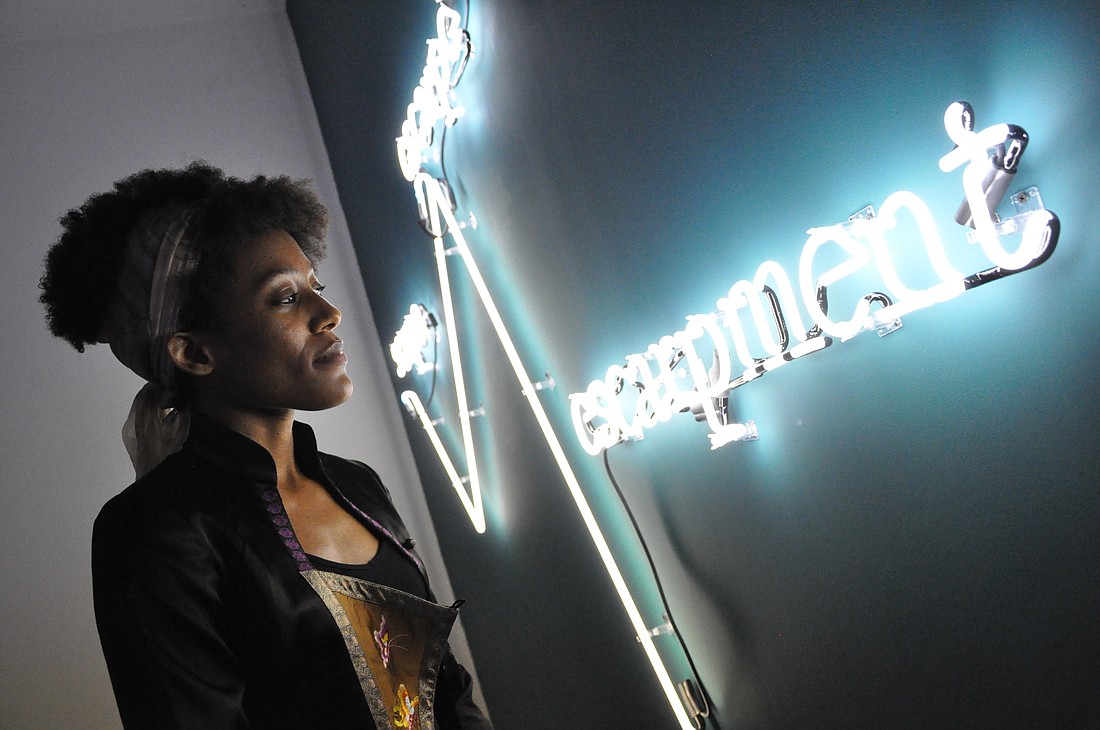- November 21, 2024
-
-
Loading

Loading

Time. Space. History. Geology. How does an artist capture these broad concepts that make us think and view our world through a different lens?
Miami-based artist Jamilah Sabur uses a mix of almost every art medium you can think of — whatever she needs to stand as a witness.
Sabur will be giving an artistic performance, titled “A Derivation of Time,” Tuesday, Oct. 2 at the Cornell Fine Arts Museum on the campus of Rollins College.
The performance, which will focus on etymology and geology, is an extension of her current exhibit on display at Cornell, “Ibine Ela Acu/Water Sun Moon.” The collection of filmed performances and installed artwork focuses on Sabur’s research and affinity for the nuanced terrain of Central Florida, including the highest points of the region and the directional flow of the St. Johns River. The title of the exhibit comes from language of the Timucua – a Native American tribe that was once settled in the region but has been extinct for hundreds of years.
Sabur explores not only the origins of violence and history of colonialism in Florida but also the different characteristics of the local environment and its relation to the concept of time.
In one video piece, called “Untitled (rhombus: above Lake Apopka North Shore),” Sabur stands on one of the highest points in Florida: Sugarloaf Mountain in Lake County off the shore of Lake Apopka. An overhead camera films Sabur wearing a mask and kneeling in front of a rhombus shape placed on the ground. She explained the shape originated from a piece of architecture she recalls from her mother’s childhood home in Jamaica — it serves as a metaphorical link between Sabur’s ancestral home and Lake Apopka.
The video is used to convey the magnitude of the geographical area, its beauty and the futility of borders and owning territory in the grand scheme of time.
“My practice is kind of rooted in a conceptual base,” Sabur said. “For me, (I use) every mode, every means necessary in exploring this thought, this idea. It’s so much rooted in this basic sense of learning and knowing. In much older works, I used to make kinetic sculptures. For me, at the base, it’s about process.”
Another piece in the current exhibit at the Cornell Museum showcases Sabur’s craftsmanship with neon lights. “Origin and etymology of escarpment” examines a word that means a steep slope that occurs at the edge of a plateau, paired with lines that create a sloping image. Sabur said the word “escarpment” can relate to both time and a physical landscape, which relates back to the concepts she explores in the exhibit.
“In her practice, Sabur challenges the notion of time as a concrete measurement,” a description at the entrance to the exhibit states. “Time is very much a central component; however, layers of time accumulate to form new meanings. Moreover, the future can be the past and the present can be both real and imagined.”
Sabur admits she is half artist and half philosopher.
“One of the themes that I always go back to with my practice is this sense of time — this is definitely the ultimate philosophical exploration,” Sabur said. “It’s thinking about space, the gaps in how we recall memory. That’s always a core within my thinking.”
Cornell Fine Arts Museum Director Ena Heller said Sabur brings a fresh and fascinating perspective with her unique exhibition.
“Jamilah’s art, for us, brings together so many of the things that we are interested in exploring as a museum and as a college,” she said. “It was really amazing to see her research of Florida history and the way it resonates with her as a young person living in Florida. What I really love about her art is connecting these big issues — like the lost history of the Timucua, the history of Florida and the environment and bringing them all together into this very personal art.”
Sabur said she hopes people who come to see her exhibit and performance Oct. 2 will walk away with a new perspective. An artist can function as a witness, she said, and that’s what she’s sought to do with her work.
“How I see the work functioning is this extension of really wanting to have people re-shift their gaze, re-shift their sense of scale,” Sabur said.